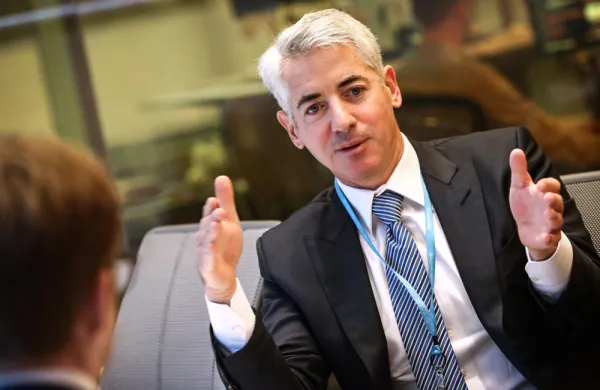Trying to impress New Yorkers with money is like trying to impress Muscovites with snow: The stuff is just too commonplace. Yet never before in the annals of wealth and power in Manhattan has there been an upswelling of plutocracy quite like the ascendancy of hedge fund managers. Even the most blasé Gothamites are taking note.
But then, never before have so few made so much so fast. Just to appear on the 2005 list of the top 25 hedge fund earners in Alpha, II's sister publication, required $100 million. To come out No. 1 took an astonishing $1 billion, a distinction earned by Edward Lampert of ESL Investments. In all, the 25 hedge fund managers on our rich list reaped an average of $251 million from fees and from gains on their investments in their funds. By comparison, the CEO of a typical top 500 U.S. corporation hauled in a measly $10 million last year. That $251 million, by the way, stacks up nicely against the comparable figure for the hedge fund managers on the 2004 rich list: $207 million. Or that for the year before: $110 million.
Now, like the really rich before them, hedge fund managers are asserting themselves beyond the business sphere: in the arts, in politics and in society. And they are reshaping the upper end of the markets in two commodities that ultra-affluent New Yorkers cherish: fine art and luxury real estate. "Hedge fund managers are absolutely the reason the art market is soaring," says Milton Esterow, editor and publisher of ARTnews. Allan Schwartzman, an adviser to private collectors and museums, calls hedge fund managers "voracious" collectors.
Steven Cohen of SAC Capital Advisors (whose earnings of $450 million put him at No. 4 on our top 25 list) has rapidly assembled a serious collection of contemporary and modern art. He reportedly paid $52 million for a Jackson Pollock, $20 million for a Manet and $25 million for a Warhol. Cohen also shelled out $8 million for Damien Hirst's Physical Impossibility of Death in the Mind of Someone Living, a 14-foot tiger shark entombed in formaldehyde. ARTnews has named Cohen one of the world's top ten art collectors for the third straight year.
Kenneth Griffin of Citadel Investment Group (No. 8 on our list, with $240 million) made the ARTnews ranking for the first time last year, after plunking down an undisclosed sum for a Cézanne still life, Curtain, Jug and Fruit Bowl; it sold for $60.5 million in 1999. At least eight hedge fund managers were among the magazine's 200 top art collectors in 2004.
Of course, important art demands an appropriate showcase. Cohen is said to be forking over $24 million for two apartments at One Beacon Court in midtown Manhattan so that he can create a duplex pied-à-terre on the upper floors. (His main residence is in Greenwich, Connecticut.) No word yet on whether the shark is going up- or downstairs.
Collecting property can be almost as gratifying for hedge fund tycoons, apparently, as buying paintings or large fish. "Hedge funds have had a big effect on the real estate market," reports Barbara Corcoran, chairwoman of New Yorkbased real estate firm Corcoran Group. "The very top tier has been changed by hedge funds."
To offer another example in the eight-digit domain (anything less is ho-hum): York Capital Management's James Dinan (whose $125 million in earnings place him No. 14 on our rich list) reportedly paid $21 million for a Fifth Avenue co-op owned by former Tyco International chief executive L. Dennis Kozlowski. And Caxton Associates' Bruce Kovner, third on the rich list (with $550 million), is said to be spending well upwards of $20 million to refurbish the 20,000-square-foot Federal-style mansion he bought on New York's Fifth Avenue in 1999 for $17.5 million.
Whatever cultural or social (or property) ambitions the top 25 hedge fund managers may have, they landed on our list because they have been superb investors over the long haul. But in a notable development, they are no longer quite so reserved about it: Not content to look for opportunities in today's lackluster markets, many are making things happen through aggressive shareholder activism of a sort not witnessed in more than two decades.
"Hedge funds are definitely flexing their muscles," declares George Bason Jr., co-head of the merger practice at New York law firm Davis Polk & Wardwell. Adds former Georgeson Shareholder Communications vice chairman John Wilcox, who recently joined TIAA-CREF as head of corporate governance, "It reminds me of the role arbitrageurs played in the 1980s, when we had financially driven takeovers."
Hedge funds played pivotal, and well-publicized, roles in the ouster of the head of Deutsche Börse and in the shake-up of the board at video rental chain Blockbuster. The striking thing about this new hedge fund activism is how pervasive, and how relentless, it has become.
Late last year Perry Capital's Richard Perry, No. 13 on the rich list (with $153 million), engineered a complex and controversial transaction involving his Perry Partners fund with the aim of ensuring that Mylan Laboratories completed its purchase of King Pharmaceuticals, in which Perry Partners had a sizable interest. Perry scooped up enough shares of Mylan to be able to exert sway in the generic-drug maker's boardroom as the company's largest shareholder. Simultaneously, however, he shorted an equal amount of Mylan stock to hedge his bet. Despite all this maneuvering, the Mylan-King merger -- fiercely opposed by Mylan shareholder and onetime corporate raider Carl Icahn -- appeared to have collapsed as of mid-May, because of accounting issues at King. Nonetheless, Perry's ploy underscores the lengths to which hedge fund managers will go to do deals.
In March, Beverly Enterprises agreed to put itself up for sale two months after Appaloosa Management's David Tepper -- who made $420 million last year, placing him at No. 5 on the rich list -- and other investors proposed to buy the nursing home company. The investors won the right to participate in the auction of Beverly.
"I'd be lying to say I didn't look up to guys like Carl Icahn, T. Boone Pickens, the Coniston Partners, Irwin Jacobs -- people like that -- as corporate heroes," says one of the more activist hedge fund managers, Daniel Loeb of Third Point (No. 20, with $110 million). "I was in my early 20s, and these guys were coining serious money by buying positions in undervalued companies and taking on entrenched management head-on."
Perhaps the exemplar of the hedge fund activist writ large is ESL's Lampert -- the first to crack the $1 billion mark in our four-year-old survey. Last year he orchestrated a merger between two of his holdings, shopworn retailers Sears, Roebuck & Co. and Kmart Holding Corp. Lampert's majority stake in Kmart, mostly bought while the company was in bankruptcy, more than tripled in price last year. Meanwhile, his Sears shares surged 12 percent. ESL racked up an estimated 69 percent gross return.
Lampert was hardly the only hedge fund manager to break the bank despite decidedly lackluster returns for hedge funds as a group. (Consulting firm Hennessee Group calculates that the average hedge fund was up just 8.3 percent last year.)
Quant guru James Simons of Renaissance Technologies Corp. made $670 million, putting him at No. 2 on the list. His Medallion fund rolled up a 24.9 percent net gain. SAC Capital's Cohen managed 23 percent net. Caxton's Kovner can't brag about his performance -- his Caxton Global Investments fund was up 9.9 percent in 2004 -- but he has such a huge personal stake in his funds from years of exceptional returns that he still finished high up on the rich list.
On the whole, the biggest earners tended to do well both because they had lots of their own capital in their funds and because they achieved great performance. Others less wealthy (though hardly poor) benefited principally from extraordinary gains. The best example: Tontine Associates' Jeffrey Gendell, No. 12 on the rich list. His take was $180 million, mainly because his key fund rolled up a 101.4 percent net return.
Still others of the top 25 collected huge sums despite so-so returns, because they have so much capital in their funds. The single-digit (net) set includes Kovner; Soros Fund Management's George Soros (No. 6), who made $305 million; and Highbridge Capital Management's Glenn Dubin and Henry Swieca (tied at No. 18), each of whom earned $115 million.
Hedge fund managers, of course, cultivate secrecy almost as assiduously as they do returns. But even those who have not set out to become activists are collectively moving the markets. Consulting firm Greenwich Associates found that in 2004 hedge funds accounted for 82 percent of trading in U.S. distressed debt and almost 30 percent of trading in U.S. credit derivatives and sub-investment-grade bonds. Cohen's $6 billion-in-assets SAC Capital is alone responsible for about 3 percent of the trading volume on the New York Stock Exchange.
Such clout may not be altogether a bad thing. Federal Reserve Board chairman Alan Greenspan, for one, has said that "hedge funds have become major contributors to the flexibility of the financial system -- a development that proved essential to our ability to absorb so many economic shocks in recent years."
Yet even for excess-inured New Yorkers, the shock of hedge fund managers' pay may take some getting used to.





